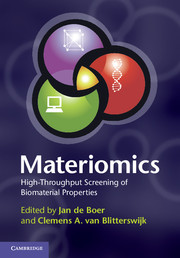Book contents
- Frontmatter
- Contents
- List of contributors
- Preface
- Chapter 1 Introducing materiomics
- Chapter 2 Physico-chemical material properties and analysis techniques relevant in high-throughput biomaterials research
- Chapter 3 Materiomics using synthetic materials: metals, cements, covalent polymers and supramolecular systems
- Chapter 4 Microfabrication techniques in materiomics
- Chapter 5 Bioassay development
- Chapter 6 High-content imaging
- Chapter 7 Computational analysis of high-throughput material screens
- Chapter 8 Upscaling of high-throughput material platforms in two and three dimensions
- Chapter 9 Development of materials for regenerative medicine: from clinical need to clinical application
- Chapter 10 Non-biomedical applications of materiomics
- Chapter 11 Beyond bed and bench
- Index
- References
Chapter 1 - Introducing materiomics
Published online by Cambridge University Press: 05 April 2013
- Frontmatter
- Contents
- List of contributors
- Preface
- Chapter 1 Introducing materiomics
- Chapter 2 Physico-chemical material properties and analysis techniques relevant in high-throughput biomaterials research
- Chapter 3 Materiomics using synthetic materials: metals, cements, covalent polymers and supramolecular systems
- Chapter 4 Microfabrication techniques in materiomics
- Chapter 5 Bioassay development
- Chapter 6 High-content imaging
- Chapter 7 Computational analysis of high-throughput material screens
- Chapter 8 Upscaling of high-throughput material platforms in two and three dimensions
- Chapter 9 Development of materials for regenerative medicine: from clinical need to clinical application
- Chapter 10 Non-biomedical applications of materiomics
- Chapter 11 Beyond bed and bench
- Index
- References
Summary
Introduction to materiomics
The ability to regenerate and repair tissues and organs – using science and engineering to supplement biology – continuously intrigues and inspires those hoping that the frailty of our bodies can be ultimately avoided. From ancient times, a surprising range of unnatural materials have been used to (partially) substitute human tissues for medicinal purposes. For example, in the era of the Incas (c. 1500), moulded materials such as gold and silver were used for the ‘surgical’ repair of cranial defects. In addition, archaeological findings reveal a wide range of materials, such as bronze, wood and leather, being used to replace and repair parts of the human body. Continuous refinement led to the first evidence of materials successfully implanted inside the body, reportedly used to repair a bone defect in the seventeenth century (see Further Reading).
Even earlier than this, the relationships between anatomy (i.e. structure) and function of living systems had been explored by Leonardo da Vinci and Galileo Galilei, who were among the first few to apply fundamental science to biological systems. In the current age of technology, new materials for biomedical and clinical application have undergone a modern Renaissance, resulting in a surge in design and successful application (1–5). The concepts of tissue repair and substitution are constantly improving and becoming more accessible, as proven for example by the widespread occurrence (and popular approval) of total hip and knee replacements. But rather than replacement with synthetic analogues, can biological tissue(s) be directly engineered?
- Type
- Chapter
- Information
- MateriomicsHigh-Throughput Screening of Biomaterial Properties, pp. 1 - 12Publisher: Cambridge University PressPrint publication year: 2013



